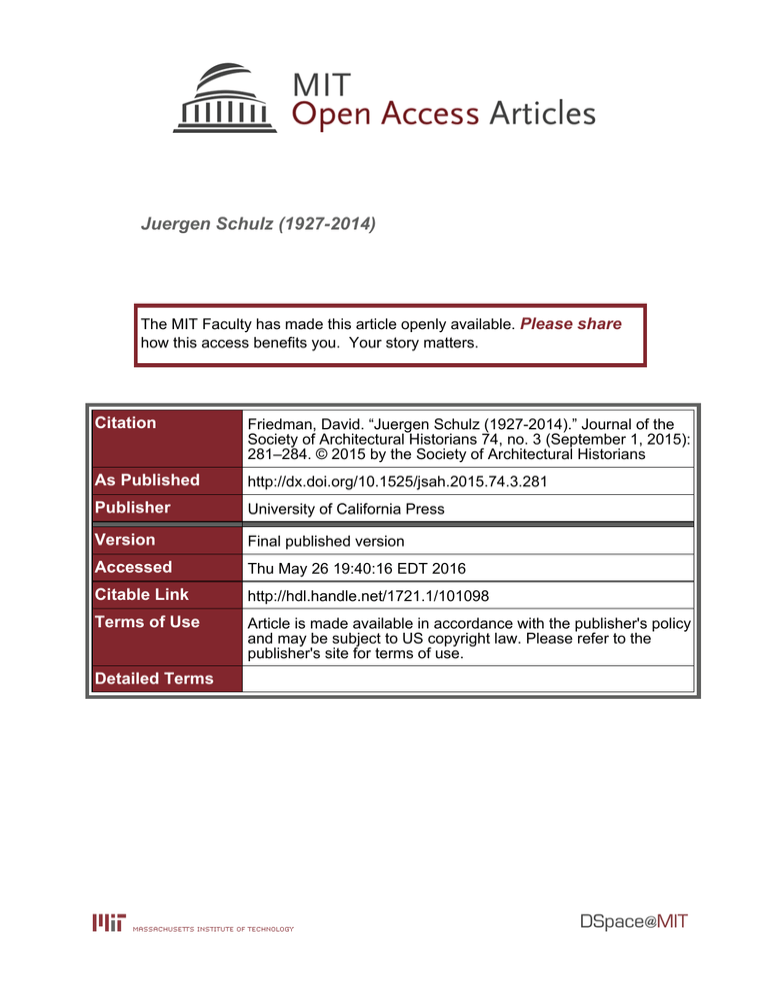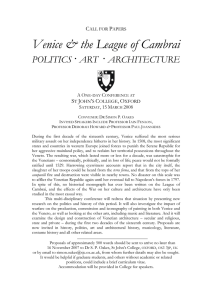Juergen Schulz (1927-2014) Please share
advertisement

Juergen Schulz (1927-2014) The MIT Faculty has made this article openly available. Please share how this access benefits you. Your story matters. Citation Friedman, David. “Juergen Schulz (1927-2014).” Journal of the Society of Architectural Historians 74, no. 3 (September 1, 2015): 281–284. © 2015 by the Society of Architectural Historians As Published http://dx.doi.org/10.1525/jsah.2015.74.3.281 Publisher University of California Press Version Final published version Accessed Thu May 26 19:40:16 EDT 2016 Citable Link http://hdl.handle.net/1721.1/101098 Terms of Use Article is made available in accordance with the publisher's policy and may be subject to US copyright law. Please refer to the publisher's site for terms of use. Detailed Terms in memoriam Juergen Schulz (1927–2014) G enerations of Venetian scholars will recall Juergen Schulz, who died on 23 November 2014, as the distinguished figure at the desk by the window in the reading room of the city’s State Archives.1 He arrived early to secure that place, and he worked through the day from his knees, a posture forced on him by the pain in his back that he would not let compromise his research. They will also remember him as the colleague who led study tours through the outback of the city to see the often obscure traces of its early urban fabric. “Venice,” he’d say, in the argot of a 1950s radio detective, “is my beat.” These are the two sides of the man. He was tall and straight, elegant and learned, but he was also down-to-earth and possessed of a lively sense of humor. He knew his way around the libraries, print cabinets, and bookshops of Europe, and he could also fix a carburetor. At home in Providence, Rhode Island, he and his wife, Anne, entertained often and well in their grand early nineteenth-century house on Bowen Street. Beautifully ordered books lined the rooms, and stack space excavated below the house accommodated a collection of Venetian material among the best in the United States. If this sounds, in part, like the description of a German professor of an earlier generation, there is good reason. ­Juergen was born in Kiel, Germany, in 1927. In 1938, when his mother managed to get her two boys out of the country, he was enrolled in a technical high school (the fact that his maternal grandparents were Jewish dictated that he could not attend the Gymnasium that prepared students for the university). By the end of the year they were settled in Berkeley, invited by his mother’s old friend Walter Horn. Juergen went through the Berkeley public schools and then the University of California there. He studied engineering, his father’s profession, and then, after being drafted into the postwar army, English. He became an American, but his mother made sure he spoke German at home. Between these two identities he Journal of the Society of Architectural Historians 74, no. 3 (September 2015), 281–284. ISSN 0037-9808, ­electronic ISSN 2150-5926. © 2015 by the Society of Architectural Histo­rians. All rights reserved. Please direct all requests for permission to photocopy or reproduce ­article content through the ­University of California Press’s Rights and Permissions website, http://www.ucpressjournals.com/reprintInfo.asp. DOI: 10.1525/jsah.2015.74.3.281. became the man he was. After college he worked as a reporter in San Francisco and then in London. In 1953 he enrolled at the Courtauld Institute of Art. He studied with Anthony Blunt and did his thesis with Johannes Wilde. For this he was compensated by the German government: the document he received said that, having been deprived of admission to a Gymnasium in his youth, he had had to endure an inferior education in adulthood. Juergen loved it. Juergen’s 1977 review of Wilde’s Venetian Art from Bellini to Titian was a tribute to his beloved teacher and a manifesto of his own scholarly values. The book was “the most ­intelligent . . . introduction to Venetian High Renaissance painting that has been written.” Why so? “Concreteness of observation” was the essence of the work, manifest in “the countless comments on formal solutions and tradition, [on] sources, pentimenti, and alterations . . . [all] the fruit of ­Wilde’s long and infinitely patient commerce with the works themselves.” All this led to a focus “on individual works and on qualities inherent in them rather than preexistent in the writer’s mind.”2 Juergen, who always said that he would rather be right than brilliant, learned how to be “right” from Wilde. Juergen’s thesis, on Venetian painted ceilings of the Renaissance, was published by the University California Press in 1968.3 The book’s structure would serve as the model for many of his projects. Its foundation is a catalog that lays out the history of each ceiling, collects the contemporary evidence, and recounts the historiography. The interpretive essays set the ceilings into a broader history of Venetian sixteenth-century painting, establish a development, analyze narrative and visual structures, and identify both the characteristic Venetian elements of the ceilings and the contributions of other Italian artistic traditions. It is characteristic of all Juergen’s Venetian projects that the works are never seen as uniquely local achievements. In his writing they all belong to the greater world of European art and culture. The history of painting remained a cornerstone of Juergen’s teaching, but his research interests migrated to the more pragmatic topic of the city, which for him could only mean Venice. He began systematically, with a catalog of the printed images of the city (published in Saggi e memorie 1970).4 281 He thought of the collection as an instrument for the study of the history of architecture and urban planning, a useful tool “that there seemed no way of having, short of composing it myself.” As always, his interpretive essay began at the beginning, in this case with a history of settlement in the lagoon. This was a subject to which he would return in 2010 to put to rest a favorite myth of Venetian history. His analysis of the archaeological evidence of sites from around the lagoon showed a history of settlement that stretched back to Roman times and, in doing so, debunked the idea that Venice was founded ex novo in the sixth century by a Roman people fleeing the lower Po Valley in the face of the Longobard invasion. The centerpiece of any history of images of Venice is Jacopo de’ Barbari’s view of the city of 1500. Juergen famously returned to this entry in the catalog in an essay published in the Art Bulletin in 1978.5 The fifty-page article reconsiders almost every aspect of the earlier interpretation and, in addition, embeds the print within a learned history of the early modern city view. The article pioneered fundamentally new ways to interpret images of this kind, ways that have had a profound influence not only on the treatment of maps and views by art historians but also on the way historians of cartography view their material. Two aspects of the essay have had the greatest impact. The first is the shift of attention from the topographical content of the view to its iconography. Juergen called attention to the title of the print. Venetie, ­ablative, “at Venice,” announces the theme. The figures of Mercury (“I Mercury shine favorably on this above all other emporia”) and Neptune (“I Neptune reside here, smoothing the waters at this port”) are read as integral parts of the image. Gondolas ride out for the ritual marriage of the city with the waters that lead to the East. The gap in the Alpine ridge of the background signals the Brenner Pass, which carries trade to the north. “The subject, in other words, is the commonwealth of Venice rather than the physical city.” Because the Barbari view is a landmark of Renaissance cartography, the literature on the work agreed that it must also be the product of the geometrically based systems of survey and mapping first described in the fifteenth century. Juergen argued that it is not. In an illustration that superposed the lines of a spatial grid from a modern plan of the city onto the Barbari view, matching the territory inscribed in each square of the grid with the same territory in the view, he showed the way the artist stretched and squeezed different parts of the city to produce his image of Venetie. Juergen was the first to apply this sort of analysis—now the everyday work of the computer—to urban representation. He made the drawings himself, using the intellectual and drafting skills developed during that early engineering education. For Juergen the view was an image assembled on the drafting table—a masterpiece, yes, but of artistic vision, not mathematics. 282 j s a h | 7 4 . 3 | S e p t e m b e r 2 0 1 5 The architectural studies for which Juergen assembled the catalog of printed images of Venice did not begin to appear in print until 1982. The subject was the pre-Gothic palaces of the city. Articles on individual buildings culminated in the 2004 publication of The New Palaces of Medieval Venice.6 The book is founded on a meticulous collection of primary evidence—written documents, images, restoration records, and firsthand inspection of the building—published in appendixes. From this evidence Juergen drew important new conclusions. The palaces are justly famous as the first monumental private residences of Europe and the first to display themselves with richly decorated façades. It was the façades that had preoccupied previous scholars. Juergen focused instead on the plan and the development of the building type. The earlier scholarship had looked for the ­origin of the Venetian palace in buildings supposed to have had arcaded façades. Because of Venice’s long attachment to Constantinople, and despite the absence of any evidence of arcaded façades there, the palaces of that city were commonly cited as the source of the Venetian type. Another theory proposed an even more distant model: the arcaded villas of the late Roman mainland. Always skeptical of longaccepted truths, especially those that isolated Venice from its European context, Juergen argued for another lineage. For him the beginning of the new palaces was found in the arcaded upper-hall buildings distantly derived from the residences of the medieval emperors and adapted in the twelfth century to the town halls of mainland Italian cities and then to the residences of the urban elite. At Venice there are twelfth-century halls that face internal courts. It was only later that the hall was laid across the short side of the lot and onto the canal. The shift, in Juergen’s view, was based on politics as much as on physical necessity. When the family derived its power from its position within the neighborhood, the court and the doorway leading to the campo and the parish church were the main orientation of the residence. Only when the government at San Marco centralized the city’s politics was the canal side of the house, especially if it faced the city’s preeminent public thoroughfare, the Grand Canal, developed in the form of an arcaded façade to display the status of the family to the community of the elite. Juergen’s early career in journalism was not lost on his art historical production. His writing style remained succinct and direct even as it took on the sophisticated language of art history. New Palaces conveys its interpretive message in eighty pages; its appendixes contain just the facts. Essays that reviewed the literature on, say, the palaces or city views could show a sharper tone, and Juergen’s work as book review editor for the Art Bulletin revealed him as a meticulous critic. We get a more illuminating glimpse of the spirited personality enjoyed by his friends in the freer language of his book reviews. In one such essay Juergen laments the frugality of the publisher who did not allow the author to publish the full texts of his scholarly sources. Without them, “even if [the reader] be so fortunate as to be in London, New York, or Florence, he will be in for an unpleasant time of it nonetheless, with all his fingers, pens, and papers deployed to hold his place in the dozen books and journals he will require for consultation with every paragraph of the catalogue.”7 Clearly this was what Juergen expected of a serious scholar, and it was what he did as an editor at the Art Bulletin. Only rarely did he give his wit completely free rein. In an essay that reviewed interpretations of the Barbari Venetie, he commented on a study that characterized the form of the city as that of the iconographically significant figure of a dolphin: “Tutt’ al più essa appare simile ad una sogliola, ma mi sembra meglio tralasciare I raffronti ittiologici” (At best it seems more like a flounder, but it’s probably better to put these ichthyological comparisons aside).8 When Juergen took on institutional commitments, he was fully engaged. The major undertaking of his university career was the transformation of the art department at Brown. By the time he arrived in Providence in 1968 he had already negotiated the building blocks of a new regime: an annual budget for book acquisition and the university’s commitment to an expanded, more fully professional faculty. Cathy Zerner, Kermit Champa, Sheila Bonde, Jeffrey Muller, Dietrich Neumann, Maggie Bickford, and Dian Kriz were all hired under Juergen’s chairmanship, and with this growing resource a PhD program was established. ­Juergen had an easy, friendly relationship with the graduate students, running seminars that were “like engaged conversations among colleagues,” as one student put it. He took survey classes seriously, too. For him art history was a whole and his students needed a good idea of its range. He lectured with complete concentration, so focused that he once fell off the stage during a lesson. Among other things, he was “an objects man.” He had been an associate curator at the University Art Museum at Berkeley, and at Brown he fostered the tradition at the Bell Gallery of student-curated exhibitions, complete with scholarly catalogs. Connoisseurship was part of Juergen’s training, and it remained a tool of his research (he chaired a session to reconsider its methods at the 1993 meeting of the College Art Association) even when the subject was thirteenth-century architecture. When Juergen arrived at Brown, Philip Johnson’s List Art Center was in the works, and Juergen immediately immersed himself in the planning. The new shape of the department indicated, to Juergen at least, necessary modifications. He fought for a more democratic distribution of space, prevailing despite Johnson’s deep dissatisfaction. Juergen retained a lively interest in the building and, with Dietrich Neumann, was writing a history of the project at the time of his death. In Italy, Juergen served with great pleasure on the advisory board of the Palladio Center in Vicenza. Invited to join the board in 1985 when the center expanded the range of its interests, he became one of the board’s most active and dedicated members. He organized conferences and educational programs, edited and wrote for the center’s publications (the earliest on north Italian squares in 1990 and the most recent on Gothic architecture in the Veneto in 2010), and served as acquisition adviser to the library, adding further purpose to his great passion for books, bookshops, and book catalogs. The annual meeting of the board was a fixed date on his calendar. Juergen was a confident critic—he “knew his mind,” as one student put it—but an openhearted and generous one. His judgment was uncompromising, and for that reason his praise was highly prized. I always suspected that he didn’t think too much of the first article I wrote on city views. He never said a word about it. So when he sent a generous note about a talk he heard me give last year, I could not have been more pleased. Areli Marina said the same thing about a letter Juergen wrote complimenting her Parma book. Juergen was neither suspicious nor defensive. This story circulated widely in Venice: recently arrived in the city to begin work on his thesis, he met another young scholar at a bar, maybe a bar near the archives. They struck up a conversation, which of course turned to the question “What are you working on?” The answer was the same for both: Venetian ceilings. The solution was straightforward: the two simply divided up the work. Juergen took the painting, Wolfgang Wolters the sculptural frames. ­Collaboration with others sometimes worked less well. When circumstances warranted, Juergen shared his material freely, even at the risk of having it used by those he helped. Juergen was even able to describe plagiarism with humor: it was “a form of flattery.” Juergen’s advice was sought by countless younger colleagues in Venice, and it was freely given. A quick search in JSTOR brings up more than a dozen acknowledgments of Juergen’s assistance and advice. Pat Brown credits him with the careful editorial review that gave her Venetian Narrative Painting its very successful final form. He had a similar mentoring role, over a much wider range of subjects, as Kress Professor at the Center for Advanced Studies in the Visual Arts (CASVA) in 2000–2001. He loved the exchange and formed lifelong friendships. And the friendships were not all about work. At CASVA Juergen was the best square dancer; at Brown, in addition to hosting elegant dinners, he fixed lawn mowers for colleagues and helped them buy used cars. Explaining the vagaries of English spelling and punctuation inspired a long and entertaining letter to his colleague Dietrich Neumann, newly arrived from Germany. Juergen spurred on the List Center history project with emails headed “Shades of List,” “Immer weiter und immer heiter” J u e r g e n S c h u l z ( 1 9 2 7 – 2 0 1 4 ) 283 (Ever onward, ever cheerful), and, once, when the weather suggested it, “Sturm und Drang” (“Dear Dietrich; today’s Sturm, has roused in me the Drang to press forward with the List article”). There were many invitations, including a last one to Anne Schulz’s lecture at the Met three days before Juergen’s death. Dietrich sat next to Juergen and has described him as being in high spirits, beaming with pride at Anne’s accomplishment: “That is how I remember Juergen, as one of the most generous, gregarious, warmhearted ­persons one could encounter.” david friedman Massachusetts Institute of Technology Notes 1. For information and recollections that contributed to this essay I owe a debt of gratitude to Guido Beltramini, Sheila Bonde, David Brown, 284 j s a h | 7 4 . 3 | S e p t e m b e r 2 0 1 5 Pat Brown, Giorgio Gianighian, Deborah Howard, Walter Leidtke, Areli Marina, Dietrich Neumann, Paola Pavanini, and, most of all, Anne Schulz. 2. Juergen Schulz, review of Venetian Art from Bellini to Titian, by Johannes Wilde, Burlington Magazine 119, no. 890 (May 1977), 356–57. 3. Juergen Schulz, Venetian Painted Ceilings of the Renaissance (Berkeley: University of California Press, 1968). 4. Juergen Schulz, Saggi e memorie di storia dell’arte (Florence: Leo S. Olschki, 1970). 5. Juergen Schulz, “Jacopo de’ Barbari’s View of Venice: Map Making, City Views, and Moralized Geography before the Year 1500,” Art Bulletin 60, no. 3 (1978), 425–74. 6. Juergen Schulz, The New Palaces of Medieval Venice (University Park: Pennsylvania State University Press, 2004). 7. Juergen Schulz, review of The Architecture of Michelangelo, by James S. Ackerman, and Michelangelo’s Theory of Art, by Robert J. Clements, Journal of Aesthetics and Art Criticism 21, no. 1 (1962), 93. 8. Juergen Schulz, “Revisitando la grande veduta di Venezia di Jacopo de’ Barbari,” in L’attenzione e la critica: Scritti di storia dell’arte in memoria di Terisio Pignatti, ed. Maria Agnese Chiari Moretto Weil and Augusto Gentile (Venice: Il Poligrafo, 2008), 94.



